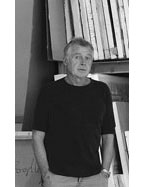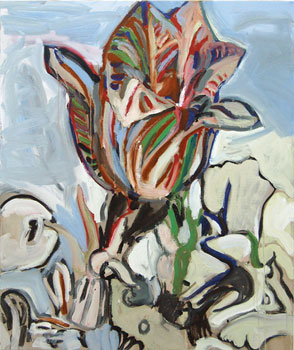

'Small Tulip,' 2010, Oil on canvas, 48' x 40'
Photo: Joshua White, courtesy George Lawson Gallery
Like his savvy, richly sensual paintings, Roger Herman eschews easy labels. During the 1980s, he was briefly dubbed a “neo-expressionist.” And in their buttery exuberance, Herman’s paintings do exude an expressionistic energy. But in their choice of subject matter, both private and sociological, and often culled from art history or old magazines likes National Geographic, they are also oddly detached—“personal, but distanced at the same time,” he observes. “It’s the way I paint, the speed of the brush makes it seem expressionistic. I do them in one go, whatever it takes, a day or two. I do not alter the paintings ... I’ll do a series of ten, pick maybe three and do over the others.” In fact, Herman’s paintings are surprisingly formal, examining certain topics—from the staid modern apartment building facades or auditoria of the 80s to the effusive flowers of today—in depth, repetitively, trying different color schemes, shifting the composition this way or that to see what insights shake out. “I go a lot by structure, even if my paintings look unstructured,” he says. “I’m not really interested in flowers, for instance. I’m more interested in structure. Not even the structure of a flower: the structure of a painting.”
Born of mixed French-German parentage in Saarbrücken in 1947, Herman has navigated disparate identities since birth. He got his MFA at Karlsruhe, which at the time had such eminent post-war pioneers as Baselitz, Lüpertz, and Kirkeby among its ranks, then moved to San Francisco in 1979 on a grant, drawn by the work of Diebenkorn, David Park, Elmer Bischoff, and other Bay Area abstract figurative painters. Finding them “too Arcadian,” he moved on to Los Angeles two years later, and became a teacher at UCLA in 1985. “For a while, I painted huge self-portraits. I said to myself, ‘What does a painter paint?’ So I painted mountains, then Marat …”
Despite his reputation as a painter’s painter, Herman wears many smocks: he was a founder of the vanguard gallery Black Dragon Society in Chinatown; he makes woodcut posters; since the late 90s he has also been churning out ceramics, inspired by a student of his. Today he works and lives in an expansive space designed by architect Frederick Fisher in the shadow of Dodger Stadium; the studio includes two metal ladders from which he creates his canvases, many of them 80' x 72' or larger. (In a recent show of his mountain paintings at the Pacific Design Center, they were too tall for the space, so he leaned them against the wall.) His new works, as recently displayed at George Lawson Gallery in San Francisco, include florid cacti, glorious interlacing poppies inspired by Chinese painting, and sumptuous tulips based on a 1600s Brueghel bouquet. While one can discern a spectrum of influences in the work—from van Gogh and Picasso to various post-war artists he admires, spanning Europe, New York, California and beyond—the vibrancy, immediacy and sheer delight in the medium are clearly his own. To Herman, painting is not an answer, it is a question, a quest, a series of exhilarating forays, an ongoing dogged exploration: stripping the medium down to its constituent elements—subject, color, brushstroke, form—again and again with each work, then luxuriating in them as they bask on the brink of resolution on the canvas. It is that same open-endedness that gives his work its clearest definition, and intoxicating appeal.
A solo show of Roger Herman’s recent work, entitled “Flora: Selected Paintings,” was on view at George Lawson Gallery, in San Francisco, from April 1 – May 1, 2010. A show of Herman’s “Paintings of the 1980s” could be seen last fall at Jancar Gallery in Los Angeles.
This article was written for and published in art ltd. magazine ![]()
